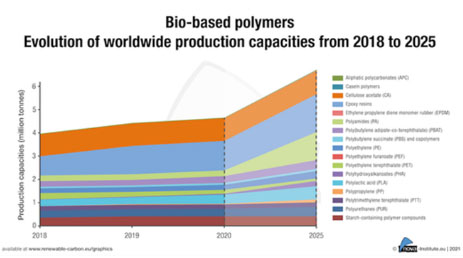Growth rate for biobased polymers exceeds overall polymer market growth
The year 2020 was a promising year for bio-based polymers: the demand for PLA in 2019 has led to the installation of increased capacities, PE and PP made from bio-based naphtha are breaking ground and there are future expansions on the horizon for bio-based polyamides as well as for PBAT, PHAs and casein polymers. A lower production is only observed for bio-based PET.

In 2020, the total production volume of bio-based polymers was 4.2 million tonnes, which is 1% of the total production volume of fossil-based polymers. For the first time in many years, the CAGR is, with 8%, significantly higher than the overall growth of polymers (3-4 %) – this is expected to continue until 2025.
Several global brands are already expanding their feedstock portfolio to include, next to fossil-based, sources of renewable carbon, CO2, recycling and especially biomass, increasing the demand for bio-based as well as biodegradable polymers. Nevertheless, at the same time, there is a lack of support from politics, which still only promotes biofuels and bioenergy.
The new market and trend report “Bio-based Building Blocks and Polymers – Global Capacities, Production and Trends 2020–2025” from the Nova Biopolymer Group shows capacities and production data for all bio-based polymers in the year 2020 and a forecast for 2025.
Overall, the global land requirement for bio-based polymers is only 0.006% of the global agricultural land. The major biomass feedstock used for bio-based polymer production is glycerol as a biogenic by-product (37%).
In the annually updated market report for the year 2020, a total of 17 bio-based building blocks and 17 polymers are described, in addition to comprehensive information on the capacity development from 2020 to 2025 and production data for 2020 per bio-based polymer.
Capacity increase
The increase in production capacity from 2019 to 2020 is mainly based on the expansion of polylactic acid (PLA) and poly(butylene adipate-co-terephthalate) (PBAT) production in Asia and the worldwide epoxy resin production. Also, increased and new production capacities for polybutylene succinate and copolymers (PBS(X)) and bio-based polyethylene (PE) and polyurethanes (PUR) were reported in 2020. Especially polyamides (PA) and polypropylene (PP) will continue to grow significantly (about 36%) until 2025. While capacities for polyhydroxyalkanoates (PHA) will grow in Asia and North America, casein polymers in Europe will increase by 32% until 2025, followed by increases in PE in South America and Europe, PLA mainly in Europe and PBAT in Asia with about 8%.
Bio-based feedstocks
Considering the steadily increasing demand for bio-based polymers, the need for biomass feedstocks should be taken into account as an important factor. This is especially true for the recurring debate on the use of food crops for bio-based polymer production. While the majority of the biomass (59%) is used for feed production, only 0.038% are needed for bio-based polymer production. That results in a biomass feedstock demand of 4.8 million tonnes for the production of 4 million tonnes of bio-based polymers and corresponds to an agricultural land share of only 0.006%.
This small area share is due to various factors: The major feedstock used for bio-based polymer production is glycerol (37%), as a biogenic process by-product from biodiesel production it represents a biomass without land use. This glycerol is mainly used for epoxy resin production via epichlorohydrin as an intermediate. The utilised biomass also comprises 24% starch and 16% sugars, both feedstocks are derived from high-yielding crops, such as maize, sugar beet or sugar cane, having a high area efficiency. 12% of the biomass are from non-edible plant oil, such as castor oil, 9% from cellulose (mainly used for cellulose acetate) and 2% from edible plant oil.
From the 4 million tonnes of produced bio-based polymers (fully and partly bio-based) only 1.9 million tonnes are actual bio-based components of the polymers (46%). Considering this fact, 2.5 times more feedstock is needed than actually is incorporated into the final product. This amount of 2.9 million tonnes (61%) of feedstock that is not ending up in the product is due to a high number of conversion steps and related feedstock and intermediate losses, as well as the formation of by-products.
Sustainability and renewable carbon
The only way for polymers, plastics and chemicals to become sustainable, climate-friendly and part of the circular economy is the complete substitution of fossil carbon with renewable carbon from alternative sources: biomass, CO2 and recycling (http://www.renewable-carbon.eu). This necessary transition is already on the strategic agenda of several global brands, that are already expanding their feedstock portfolio to include, next to fossil-based, all three sources of renewable carbon. This rethinking from the market point of view, especially in the use of biomass, will, and already did, increase the supply of bio-based as well as biodegradable polymers. Nevertheless, the market remains challenging from a political perspective and in terms of crude oil prices, as major advantages of bio-based polymers have not been politically rewarded yet: 1) Bio-based polymers replace fossil carbon in the production process with renewable carbon from biomass. This is indispensable for a sustainable, climate-friendly plastics industry. 2) Biodegradability is offered by almost half of the produced bio-based polymers. This can be a solution for plastics that cannot be collected and enter the environment. In these situations, they can biodegrade without leaving behind microplastics. Only a few countries such as Italy, France and probably Spain will politically support this additional disposal path.
Drivers and policy
The most important market drivers in 2020 were brands that want to offer their customers environmentally friendly solutions and critical consumers looking for alternatives to petrochemical products.
If bio-based polymers were to be accepted as a solution and promoted in a similar way as biofuels, annual growth rates of 10 to 20 % could be expected. The same would apply, should the oil price rise significantly. Based on the already existing technical maturity of bio-based polymers, considerable market shares could be gained in these cases.
Global production capacities of bio-based polymers by region
After Asia as leading region, which has installed the largest bio-based production capacities worldwide with 47 % in 2020, Europe follows with 26 %, followed by North America with 17 % and South America with 9 %, respectively (Figure 9). With an expected CAGR of 16 % between 2020 and 2025, Asia displays the highest growth of bio-based polymer capacities compared to other regions of the world. This increase is mainly due to higher production capacities for PA, PBAT, PHA and PLA.
(PRA)
Subscribe to Get the Latest Updates from PRA Please click here
©2021 Plastics and Rubber Asia. All rights reserved.

©2020 Plastics and Rubber Asia. All rights reserved.
Home Terms & Conditions Privacy Policy Webmail Site Map About Us













